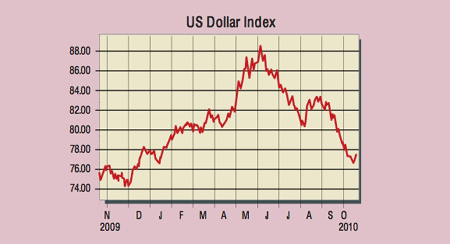
Another week, another slide in the dollar. Last week it fell to a ten-month low on a trade-weighted basis (against a basket of major trading partners’ currencies); the dollar index is now down by around 15% since June.
The greenback has also slid to a 15-year low against the yen and a nine-month low against the euro. It is at a record low against the Swiss franc. The latest decline came as Singapore widened its currency’s trading band, allowing its currency to climb against the greenback. But the US currency might be about to “spring off its deathbed”, as Colin Barr put it on Fortune.com.
The dollar has been under pressure because the Fed is set to fire up the printing presses again. “Basic economics suggests that when the supply of something increases its price should fall,” says Ron Leven of Morgan Stanley. But if quantitative easing (QE) undershoots expectations, the dollar could bounce.
There was a hint of this last Friday when Fed chairman Ben Bernanke “did not give a sense that he would be overly aggressive”, says David Rosenberg of Gluskin Sheff. Bond yields, which had slumped over the past month as the market appeared to price in around $1trn of QE, rose, and the dollar firmed.
But the key reason to expect the dollar to snap back is that just about everyone expects it to fall further. So many investors are betting on a dollar decline that the net number of short positions is at a three-year high. Credit Suisse notes that, judging by the last ten years, once bearishness reaches such extremes, the dollar index bounces.
There is apparently a 100% chance that it will be higher in three months; on a one-, two- and six-month basis, it has rallied 80% of the time, says Credit Suisse. In short, when everyone’s a seller, there’s nobody left to sell and the market changes direction.
A rebound would be unlikely to herald a long-term recovery; after all, “nobody is going to be printing as much money as Bernanke”, says Rosenberg. But the dollar could well bounce back rapidly as investors cover their short positions. And given the strong inverse relationship between the dollar and stocks (and other risky assets), a short-covering dollar rally is now “the greatest single risk” to their strong recent performance, says Eoin Treacy on Fullermoney.com.